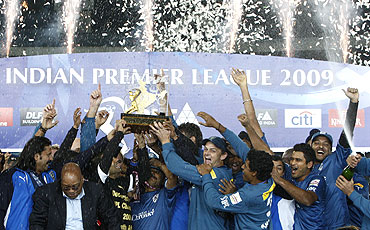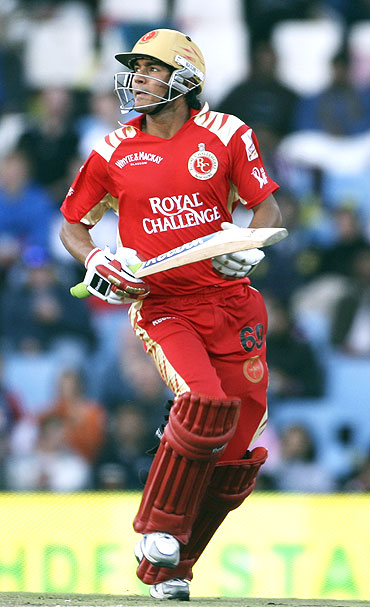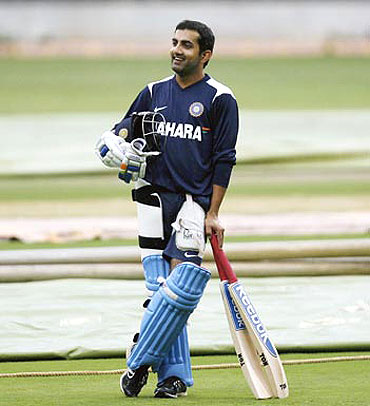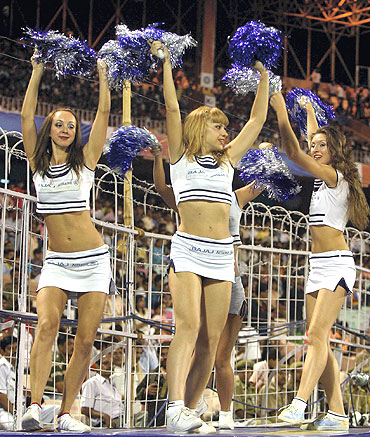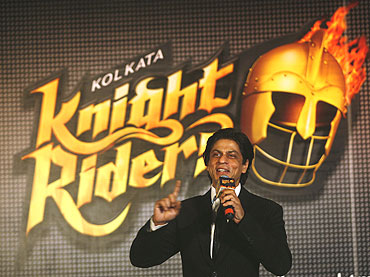 | « Back to article | Print this article |
IPL-3 set to elipse saas-bahu soaps and reality shows
That time of the cricket calendar is here again. In less than a week, IPL-3 will return, eclipsing - for the 44 days of the tournament - the saas-bahu soaps and reality shows on prime time television. Cricket will once again be the main act in the circus ring, looking to entice viewers with its high adrenaline format. But before we move ahead, it is important to look back.
Two years ago when the Indian Premier League (IPL) was launched amid fanfare, its organisers were clear that they didn't want something that was just a local phenomenon. They wanted a global brand, perhaps not in the league of the English Premier League or the National Football League, but close. There were enough sceptics, however, both on the cricketing as well as business front, who raised doubts at the sums of money being thrown around for team ownership and players, for ad rates and TV rights.
The first season of IPL held in India was a runaway success. TV ratings were promising, stadiums were packed, advertisers loved it and it was hot property with marketers. IPL-2 showed that the crowds would come, whether a match between Mumbai Indians and Rajasthan Royals was held in Chandigarh or Cape Town.
Advertisers would follow wherever the IPL bandwagon went. "IPL has entertainment value, as it is unpredictable, fast-paced and riveting," says Shailendra Singh, MD, Percept India Limited. On paper, the IPL looks a winner.
But scratch the surface and you can see the cracks. In a subtle criticism of IPL, former India captain Rahul Dravid recently said that youngsters today lack passion for Test cricket.
"There is no all-consuming desperation for them like there was for me or cricketers of my generation to do well in Tests," said Dravid.
Dravid has a point. While cricketers talk about Test cricket being the ultimate 'test', they are happy to showcase their talent in the IPL extravaganza.
Has IPL thrown up new talent?
However, the bigger question is - have our players benefitted from this commercial juggernaut? Have cricket lovers been enriched by Lalit Modi's brainchild or have we been hoodwinked by the hoopla?
For instance, other than Manish Pandey's unbeaten knock of 114 in IPL-2, which Indian player has stood up to be in the reckoning for the national squad?
Distinctions in the batting or bowling department have been grabbed by established heavyweights such as Brendon McCullum, Matthew Hayden, Shane Warne, Adam Gilchrist or Anil Kumble.
So the chances of a young player laying claim to be the future of Indian cricket on the basis of his IPL performance look bleak.
As former India captain Bishen Singh Bedi says, "They are happy to be part of the glitz and aren't willing to work hard to earn a place in the Indian team."
Performing well in a few IPL matches does ensure that the player makes it to the national team for a couple of One Day and T20 matches. But this is not enough.
"Youngsters these days want to play for an IPL team more than they want to play for India," argues Roger Binny, a member of the 1983 World Cup winning Indian team.
From IPL to India XI
In India's recently concluded two Test series against South Africa, Wriddhiman Saha was included in the national team solely on the basis of his performance in the earlier editions of IPL, but the selectors came under fire for including him ahead of the more solid Dinesh Karthik.
Then there are Gautam Gambhir and Amit Mishra, who have had strong showings in the IPL. But these two are not just the byproducts of the tournament that until now has done precious little to further the skills of budding cricketers.
By all accounts, Gambhir will be the mainstay of the Indian team for the next five years. But he made rapid strides in all forms of the game after the 2007 Twenty20 World Cup, while Mishra made his presence felt at the selectors' door with strong performances in domestic cricket.
Fast forward to the One Day series between India and South Africa - the two top Test teams - and here, at least, there is some succour for IPL patrons. From among the playing XI that took the field for India at Jaipur, Virat Kohli, Ravindra Jadeja, Ashish Nehra and Yusuf Pathan have used their IPL performances as a launch pad for the 50-over format.
However, it remains to be seen if all four will merit a place in the Indian squad for next year's World Cup. Even if they do, will they be the fulcrum around which a billion plus hopes will revolve? With the likes of Sachin Tendulkar, M S Dhoni, Yuvraj Singh, Zaheer Khan and Virender Sehwag almost guaranteed to play the World Cup, that question has an obvious answer.
Test cricket vs IPL
What then do we make of the hullabaloo accompanying each season of the IPL?
The glamour quotient aside, almost everyone laments the fact that the series with South Africa was limited to only two Test matches. Instead we are faced with an IPL routine that promises to get longer next year, with the proposed addition of two more franchises.
Nine years ago, India and Australia's battle in March gave Indian cricket perhaps its finest Test series ever. Who knows whether we would have had another hum-dinger of a series had a third Test been scheduled in the absence of the IPL?
Reports of Test cricket suffering because of IPL might be exaggerated but there is no doubt that it is depriving discerning fans of more Test cricket.
When raw talent rub shoulders with the stars
This is not to say that there is no merit in the IPL. Its financial promise to aspiring Indian cricketers is immense - so even more parents will want their children to take to the game. It also offers players on the periphery of Indian cricket, the opportunity to share space with some of the finest talent in world cricket.
It is not every day that a young Ashok Dinda gets to rub shoulders with Shane Bond. As IPL commissioner Modi reiterates, it provides Indian cricketers a platform to showcase their talent. But these advantages are not good enough reason for either the IPL to gain precedence over Test cricket or for it to be considered a nursery that grooms talent.
Budding cricketers ought to come up from a robust domestic cricket league. And while the money in the latter has improved tremendously over the last 20 years, it still pales in comparison to the lucre on offer in the IPL.
In the run-up to March 12 and later, there will be plenty to debate. Ex-cricketers will serve out expert opinion across news channels and reams of print will be dedicated to the matches. There will be breaking news as much as there will be scores of reruns. But in the end, will Indian cricket be better off?
Show me the money
The T20 format might favour those looking for instant gratification, but as far as the business goes, it's the exact opposite. With the kind of money invested in buying teams - the cheapest franchise went for Rs 67 crore - and in players' salaries, the returns were never going to be immediate.
"Teams knew from the start that it wasn't going to be a joyride in terms of money but the returns will be there," says Anil Srivatsa, CEO, Kings XI Punjab.
The addition of two more teams in the next season is sure to add more spice to the mix. New team owners will have a business model far more suited to the financial ball game of IPL.
Advertisers, on their part, have been happy with the way things have turned out. In the first IPL season, ad rates were priced at Rs 3 lakh for a 10-second slot which, according to estimates, has gone up to Rs 4.75 lakh in the third season.
SET Max, the broadcaster, has signed two co-presenting sponsors, Vodafone and Videocon, for around Rs 55 crore each, while associate sponsors are shelling out between Rs 35 to 40 crore each, depending on how much airtime they get.
IPL does guarantee eyeballs and while some advertisers might carp about not getting a good return on investment, most are happy to be associated with it.
"Most brands use their annual ad spends during IPL and it gives good returns," says a Mumbai-based media planner.
SET Max will have 10 associate sponsors this time, eight of which have been signed up - Pepsi, Samsung, LG and Hyundai among them.
"Brands realised the potential and were quick to jump on the bandwagon," says Santosh Desai, CEO, Future Brands.
'Win-win situation for everyone involved'
Such is the lure of the IPL that even rival channels are finding ways to convert the threat it poses into an opportunity.
For instance, Colors, the general entertainment channel, has tied up with IPL to produce four shows. One of these, IPL Rockstars, will feature 14 former contestants of music reality shows performing at various IPL venues before the matches start. Another, to go on air sometime in September, will have cricketers participating in Khatron ke Khiladi. According to Rajesh Kamat, COO, Viacom18 Group, the idea is to take IPL beyond the 44-day window.
As for teams, it's difficult to ascertain whether they are in the red because they don't disclose numbers. But experts believe that the IPL's revenue-sharing system ensures good returns. Franchisees get a 10 per cent share from broadcasting rights and 7.5 per cent from the central sponsorship money (DLF). They have also added sponsors of their own.
Shah Rukh Khan's Kolkata Knight Riders has Nokia, Tag Heuer and Reebok among its main sponsors, while GMR's Delhi Daredevils has Hero Honda and Adidas on their team jerseys.
"It's a win-win situation for everyone involved if the cards are played right," says Shailendra Singh of Percept.
